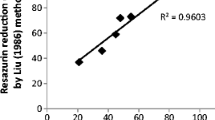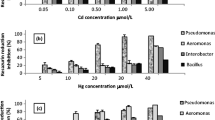Abstract
Many sophisticated water treatment plants need a reliable, fast, and economical microbial load detection method. We refined a colorimetric assay using the redox dye resazurin to assess viable microorganisms. Here, we have used a mixed bacterial suspension of significant multi-drug-resistant coliform bacteria isolated from hospital wastewater and constructed a resazurin reduction calibration curve which could accurately predict the level of microbial contamination. The number of viable microorganisms was calculated from calibration curve in terms of log colony forming units (CFU) per milliliter. Ultrasonication disinfection of bacterial suspension for a duration of 50 min measured by resazurin assay depicted a reduction of 16.94%, 26.48%, and 37.69% at 410 W, 580 W, and 700 W, respectively. A synergistic effect of the combined methods of ultrasonication and heat disinfection treatments on raw wastewater and secondary wastewater effluent was observed and was also evaluated using both resazurin assay and standard plate count method. For raw wastewater, about 1.8 log reduction was observed for ultrasonication alone and 4 log CFU/mL reduction for thermosonication. In the secondary wastewater effluent, a reduction of 2.9 and 3.2 log CFU/mL was recorded for ultrasonication and thermosonication respectively. Resazurin microbial viability test results were highly comparable with conventional colony plate count for all treatment procedures, suggesting its appropriateness for quick and reliable wastewater sample microbial viability monitoring.
Graphical abstract







Similar content being viewed by others
References
Sathya R, Arasu MV, Al-Dhabi NA, Vijayaraghavan P, Ilavenil S, Rejiniemon TS. Towards sustainable wastewater treatment by biological methods – a challenges and advantages of recent technologies. Urban Clim. 2023;47:101378. https://doi.org/10.1016/j.uclim.2022.101378.
Bizzi CA, Zanatta RC, Santos D, Giacobe K, Dallago RM, Mello PA, et al. Ultrasound-assisted extraction of chromium from residual tanned leather: an innovative strategy for the reuse of waste in tanning industry. Ultrason Sonochem. 2020;64:104682. https://doi.org/10.1016/j.ultsonch.2019.104682.
Ryecroft S, Shaw A, Fergus P, Kot P, Hashim K, Moody A, et al. A first implementation of underwater communications in raw water using the 433 MHz frequency combined with a bowtie antenna. Sensors [Internet]. 2019; 19(8).
Alattabi AW, Harris C, Alkhaddar R, Alzeyadi A, Hashim K. Treatment of residential complexes’ wastewater using environmentally friendly technology. Procedia Eng. 2017;196:792–9. https://doi.org/10.1016/j.proeng.2017.08.009.
Hashim KS, Shaw A, Al Khaddar R, Pedrola MO, Phipps D. Energy efficient electrocoagulation using a new flow column reactor to remove nitrate from drinking water – experimental, statistical, and economic approach. J Environ Manage. 2017;196:224–33. https://doi.org/10.1016/j.jenvman.2017.03.017.
Ohrdes H, Ille I, Twiefel J, Wallaschek J, Nogueira R, Rosenwinkel KH. A control system for ultrasound devices utilized for inactivating E. coli in wastewater. Ultrason Sonochem. 2018;40:158–62. https://doi.org/10.1016/j.ultsonch.2017.04.017.
Hashim KS, Adeola Idowu I, Jasim N, Al Khaddar R, Shaw A, Phipps D, et al. Removal of phosphate from river water using a new baffle plates electrochemical reactor. MethodsX. 2018;5:1413–8. https://doi.org/10.1016/j.mex.2018.10.024.
Moradi S, Rodriguez-Seco C, Hayati F, Ma D. Sonophotocatalysis with photoactive nanomaterials for wastewater treatment and bacteria disinfection. ACS Nanoscience Au. 2023. https://doi.org/10.1021/acsnanoscienceau.2c00058.
Allen MJ, Edberg SC, Reasoner DJ. Heterotrophic plate count bacteria—what is their significance in drinking water? Int J Food Microbiol. 2004;92(3):265–74. https://doi.org/10.1016/j.ijfoodmicro.2003.08.017.
Patton T, Barrett J, Brennan J, Moran N. Use of a spectrophotometric bioassay for determination of microbial sensitivity to manuka honey. J Microbiol Methods. 2006;64(1):84–95. https://doi.org/10.1016/j.mimet.2005.04.007.
Rahman M, Kühn I, Rahman M, Olsson-Liljequist B, Möllby R. Evaluation of a scanner-assisted colorimetric MIC method for susceptibility testing of Gram-negative fermentative bacteria. Appl Environ Microbiol. 2004;70(4):2398–403. https://doi.org/10.1128/AEM.70.4.2398-2403.2004.
Van Nevel S, Koetzsch S, Proctor CR, Besmer MD, Prest EI, Vrouwenvelder JS, et al. Flow cytometric bacterial cell counts challenge conventional heterotrophic plate counts for routine microbiological drinking water monitoring. Water Res. 2017;113:191–206. https://doi.org/10.1016/j.watres.2017.01.065.
Meider J. Examination of total cell count in building materials by acridine orange direct count (AODC). J Microbiol Methods. 2019;167:105725. https://doi.org/10.1016/j.mimet.2019.105725.
Grabow WO, du Preez M. Comparison of m-Endo LES, MacConkey, and Teepol media for membrane filtration counting of total coliform bacteria in water. Appl Environ Microbiol. 1979;38(3):351–8. https://doi.org/10.1128/aem.38.3.351-358.1979.
Kim HJ, Jang S. Optimization of a resazurin-based microplate assay for large-scale compound screenings against Klebsiella pneumoniae. 3 Biotech. 2017;8(1):3.https://doi.org/10.1007/s13205-017-1034-9.
Guerin M, McClenn P. Application of resazurin for estimating abundance of contaminant-degrading micro-organisms. Lett Appl Microbiol. 2001;32(5):340–5. https://doi.org/10.1046/j.1472-765X.2001.00916.x.
Toyos-Rodríguez C, Valero-Calvo D, de la Escosura-Muñiz A. Advances in the screening of antimicrobial compounds using electrochemical biosensors: is there room for nanomaterials? Anal Bioanal Chem. 2023;415(6):1107–21. https://doi.org/10.1007/s00216-022-04449-x.
Bigalke D. Methods used for monitoring the microbiological quality of raw milk. II. Recently proposed methods of raw milk microbiological evaluation. Dairy Food Sanit. 1984;4:189–90.
Kyrylenko S, Gogotsi O, Baginskiy I, Balitskyi V, Zahorodna V, Husak Y, et al. MXene-assisted ablation of cells with a pulsed near-infrared laser. ACS Appl Mater Interfaces. 2022;14(25):28683–96. https://doi.org/10.1021/acsami.2c08678.
Rampersad SN. Multiple Applications of Alamar blue as an indicator of metabolic function and cellular health in cell viability bioassays. Sensors [Internet]. 2012; 12(9):[12347–60 pp.].
Manoharan RK, Gangadaran P, Ayyaru S, Ahn B-C, Ahn Y-H. Self-healing functionalization of sulfonated hafnium oxide and copper oxide nanocomposite for effective biocidal control of multidrug-resistant bacteria. New J Chem. 2021;45(21):9506–17. https://doi.org/10.1039/D1NJ00323B.
Mukherjee A, Ahn Y-H. Terpinolene as an enhancer for ultrasonic disinfection of multi-drug-resistant bacteria in hospital wastewater. Environ Sci Pollut Res. 2022;29(23):34500–14. https://doi.org/10.1007/s11356-022-18611-6.
Wang C, Mantilla-Calderon D, Xiong Y, Alkahtani M, Bashawri YM, Al Qarni H, et al. Investigation of antibiotic resistome in hospital wastewater during the COVID-19 pandemic: is the initial phase of the pandemic contributing to antimicrobial resistance? Environ Sci Technol. 2022;56(21):15007–18. https://doi.org/10.1021/acs.est.2c01834.
Ben-David A, Davidson CE. Estimation method for serial dilution experiments. J Microbiol Methods. 2014;107:214–21. https://doi.org/10.1016/j.mimet.2014.08.023.
Chen JL, Steele TWJ, Stuckey DC. Modeling and application of a rapid fluorescence-based assay for biotoxicity in anaerobic digestion. Environ Sci Technol. 2015;49(22):13463–71. https://doi.org/10.1021/acs.est.5b03050.
Knapp JLA, González-Pinzón R, Haggerty R. The resazurin-resorufin system: insights from a decade of “smart” tracer development for hydrologic applications. Water Resour Res. 2018;54(9):6877–89. https://doi.org/10.1029/2018WR023103.
Uzarski JS, DiVito MD, Wertheim JA, Miller WM. Essential design considerations for the resazurin reduction assay to noninvasively quantify cell expansion within perfused extracellular matrix scaffolds. Biomaterials. 2017;129:163–75. https://doi.org/10.1016/j.biomaterials.2017.02.015.
Van den Driessche F, Rigole P, Brackman G, Coenye T. Optimization of resazurin-based viability staining for quantification of microbial biofilms. J Microbiol Methods. 2014;98:31–4. https://doi.org/10.1016/j.mimet.2013.12.011.
Zheng F, Wang S, Hou W, Xiao Y, Liu P, Shi X, et al. Comparative study of resazurin reduction and MTT assays for cytocompatibility evaluation of nanofibrous materials. Anal Methods. 2019;11(4):483–9. https://doi.org/10.1039/C8AY02310G.
Gibson JH, Yong DHN, Farnood RR, Seto P. A literature review of ultrasound technology and its application in wastewater disinfection. Water Qual Res J. 2008;43(1):23–35. https://doi.org/10.2166/wqrj.2008.004.
Neis U, Blume T. Ultrasonic disinfection of wastewater effluents for high-quality reuse. Water Supply. 2003;3(4):261–7. https://doi.org/10.2166/ws.2003.0071.
Anaya-Esparza LM, Velázquez-Estrada RM, Roig AX, García-Galindo HS, Sayago-Ayerdi SG, Montalvo-González E. Thermosonication: an alternative processing for fruit and vegetable juices. Trends Food Sci Technol. 2017;61:26–37. https://doi.org/10.1016/j.tifs.2016.11.020.
Liao H, Jiang L, Zhang R. Induction of a viable but non-culturable state in Salmonella Typhimurium by thermosonication and factors affecting resuscitation. FEMS Microbiol Lett. 2018;365(2):fnx249.https://doi.org/10.1093/femsle/fnx249.
Travnickova E, Mikula P, Oprsal J, Bohacova M, Kubac L, Kimmer D, et al. Resazurin assay for assessment of antimicrobial properties of electrospun nanofiber filtration membranes. AMB Express. 2019;9(1):183. https://doi.org/10.1186/s13568-019-0909-z.
Akuoko Y, Nagliati HF, Millward CJ, Woolley AT. Improving droplet microfluidic systems for studying single bacteria growth. Anal Bioanal Chem. 2023;415(4):695–701. https://doi.org/10.1007/s00216-022-04459-9.
Taylor RH, Allen MJ, Geldreich EE. Standard plate count a comparison of pour plate and spread plate methods. J - Am Water Works Assoc. 1983;75(1):35–7. https://doi.org/10.1002/j.1551-8833.1983.tb05055.x.
Sultana L, Sanchis AG. Establishing the lower bacterial concentration threshold for different optical counting techniques. J Microbiol Methods. 2022;203:106620. https://doi.org/10.1016/j.mimet.2022.106620.
Auty MAE, Gardiner GE, McBrearty SJ, O’Sullivan EO, Mulvihill DM, Collins JK, et al. Direct in situ viability assessment of bacteria in probiotic dairy products using viability staining in conjunction with confocal scanning laser microscopy. Appl Environ Microbiol. 2001;67(1):420–5. https://doi.org/10.1128/AEM.67.1.420-425.2001.
Ikonen J, Pitkänen T, Miettinen IT. Suitability of optical, physical and chemical measurements for detection of changes in bacterial drinking water quality. Int J Environ Res Public Health [Internet]. 2013; 10(11):[5349–63 pp].
Abdurahman MH, Abdullah AZ, Shoparwe NF. A comprehensive review on sonocatalytic, photocatalytic, and sonophotocatalytic processes for the degradation of antibiotics in water: synergistic mechanism and degradation pathway. Chem Eng J. 2021;413:127412. https://doi.org/10.1016/j.cej.2020.127412.
Rosario DKA, Bernardo YAA, Mutz YS, Tiwari B, Rajkovic A, Bernardes PC, et al. Modelling inactivation of Staphylococcus spp. on sliced Brazilian dry-cured loin with thermosonication and peracetic acid combined treatment. Int J Food Microbiol. 2019;309:108328. https://doi.org/10.1016/j.ijfoodmicro.2019.108328.
Al-Gheethi A, Ismail N, Lalung J, Azieda T, Kadir M. Reduction of faecal indicators and elimination of pathogens from sewage treated effluents by heat treatment. Casp J Appl Sci Res. 2013;2:29–45.
Smelt JPPM, Brul S. Thermal inactivation of microorganisms. Crit Rev Food Sci Nutr. 2014;54(10):1371–85.https://doi.org/10.1080/10408398.2011.637645.
Śmiech KM, Kovács T, Wildschut RF, Criado Monleon AJ, de Vries-Onclin B, Bowen JG, et al. Thermal disinfection of hospital wastewater in a pilot-scale continuous-flow system. Appl Water Sci. 2020;10(4):101. https://doi.org/10.1007/s13201-020-01181-8.
Tahi AA, Sousa S, Madani K, Silva CLM, Miller FA. Ultrasound and heat treatment effects on Staphylococcus aureus cell viability in orange juice. Ultrason Sonochem. 2021;78:105743. https://doi.org/10.1016/j.ultsonch.2021.105743.
Tao Y, Cai J, Huai X, Liu B, Guo Z. Application of hydrodynamic cavitation to wastewater treatment. Chem Eng Technol. 2016;39(8):1363–76. https://doi.org/10.1002/ceat.201500362.
Gibbs J, Vessels M, Rothenberg M. Selecting the detection system—colorimetric, fluorescent, luminescent methods for ELISA assays. Corning Life Sciences ELISA Technical Bulletin. 2001; Kennebunk, ME: Corning Incorporated Life Sciences
Costa P, Gomes ATPC, Braz M, Pereira C, Almeida A. Application of the resazurin cell viability assay to monitor Escherichia coli and Salmonella Typhimurium inactivation mediated by phages. Antibiotics [Internet]. 2021; 10(8).
González-Pinzón R, Haggerty R, Myrold DD. Measuring aerobic respiration in stream ecosystems using the resazurin-resorufin system. J Geophys Res Biogeosci. 2012;117(G3). https://doi.org/10.1029/2012JG001965.
Acknowledgements
This research was supported by the Basic Science Research Program through the National Research Foundation (NRF), funded by the Ministry of Education (2020R1I1A305481611), Republic of Korea. The authors thank the Research Center for Natural Products and Medical Materials (RCNM) for technical support regarding the nanoindentation test.
Author information
Authors and Affiliations
Corresponding author
Ethics declarations
Conflict of interest
The authors declare no competing interests.
Additional information
Publisher's note
Springer Nature remains neutral with regard to jurisdictional claims in published maps and institutional affiliations.
Rights and permissions
Springer Nature or its licensor (e.g. a society or other partner) holds exclusive rights to this article under a publishing agreement with the author(s) or other rightsholder(s); author self-archiving of the accepted manuscript version of this article is solely governed by the terms of such publishing agreement and applicable law.
About this article
Cite this article
Mukherjee, A., Ahn, YH. A downstream process control tool based on the redox dye resazurin for rapid and accurate measurement of microbial metabolic activity. Anal Bioanal Chem 415, 5539–5550 (2023). https://doi.org/10.1007/s00216-023-04828-y
Received:
Revised:
Accepted:
Published:
Issue Date:
DOI: https://doi.org/10.1007/s00216-023-04828-y




